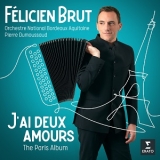Diese CD ist eine musikalische Flânerie durch Paris, vom Panthéon mit Vincent Scottos J’ai deux amours zur Pyramide des Louvre, wo der Stil-Clash mit dem äußerst effektvollen, in den Ecksätzen hoch virtuosen und an sich sehr originellen Akkordeonkonzert L’Île du Temps von Fabien Waksman symbolisiert wird.
Zum Père Lachaise erklingt das Prélude op. 28 von Frédéric Chopin in einem Arrangement für Akkordeon, Violoncello und Kontrabass von Domi Emorine und zur Tour Eiffel Hubert Girauds Sous le ciel de Paris, das Montand und Piaf unsterblich gemacht haben und in dem die großartige Julie Fuchs eine neue Qualität entdeckt.
Dass für das Théâtre des Champs Elysées die Danse Sacrale von Igor Stravinsky in einem Arrangement für Akkordeon und Klavier von Thibault Perrine gewählt wurde, liegt auf der Hand, war es doch in diesem Konzerthaus, wo der Komponist mit seinem Ballett einen riesigen Skandal verursacht hatte. Das damals Skandalöse kann die Bearbeitung mit dem spannenden Spiel von Félicien Brut und Adam Laloum am Klavier gut darstellen.
Vom TCE geht es zum Boulevard des Capucines und dem Variététheater L’Olympia, für das der Komponist Karol Beffa eine sechs Sätze umfassende Suite komponiert hat, von der auf dieser CD nur fünf Platz gefunden haben, angeblich ohne Wissen und Einwilligung von Beffa, was einer flagranten Missachtung des Komponisten gleichkommt, die sich ein Label wie Erato eigentlich nicht leisten dürfte. Karol Beffa hat für die fünf hier übrig gebliebenen musikalischen Porträts in symphonisch-konzertanter Form eine Hommage an Édith Piaf, Barbara, Charles Trénet, Charles Aznavour und Yves Montand geschaffen, die ebenso originell wie intelligent, geschmack- und phantasievoll ist und in dieser Form den Variété-Charakter hundertprozentig und sehr stimmungsvoll in die neue Musik integriert.
Moulin Rouge und Montmartre werden mit Astor Piazzollas Zita und La Complainte de la Butte von Georges Van Parys, erneut der wunderbaren Julie Fuchs thematisiert. Zum Palais Royal erklingt das Prélude Religieux aus Gioachino Rossinis Petite Messe Solennelle, zur Place de la Bastille das Caprice d’accordéoniste von Thibault Perrine, wobei dieses nicht an 1789 erinnert wird, sondern an die musikalische Revolution, die Félicien Brut im Booklet so beschreibt. « Hier hat sich vor einem Jahrhundert alles abgespielt! Die Auvergnaten, Könige des Viertels und der Musik treffen auf die italienischen Einwanderer, die in ihrem Gepäck das neue Instrument, das Akkordeon mitbringen. Gemeinsam erfinden sie einen neuen Stil von Tanzmusik: die Musette. »
Mit Accordéon von Serge Gainsbourg zum Thema Saint-Germain-des-Prés geht das abwechslungsreiche und auf hohem Niveau gespielte Programm melancholisch zu Ende.
This CD is a musical flânerie through Paris, from the Panthéon with Vincent Scotto’s J’ai deux amours to the pyramid of the Louvre, where the style clash is symbolized with the extremely effective accordion concerto L’Île du Temps by Fabien Waksman, which is highly virtuosic in the outer movements and very original in itself.
For the Père Lachaise we hear the Prélude op. 28 by Frédéric Chopin in an arrangement for accordion, cello and double bass by Domi Emorine, and for the Tour Eiffel Hubert Giraud’s Sous le ciel de Paris, which Montand and Piaf made immortal and in which the great Julie Fuchs discovers a new quality.
The fact that Igor Stravinsky’s Danse Sacrale in an arrangement for accordion and piano by Thibault Perrine was chosen for the Théâtre des Champs Elysées, is obvious, as it was in this concert hall that the composer had caused a huge scandal with his ballet. The scandalousness of that time can be well represented by the arrangement with the exciting playing of Félicien Brut and Adam Laloum at the piano.
From the TCE we go to the Boulevard des Capucines and the Variété theater L’Olympia, for which composer Karol Beffa composed a six-movement suite, only five of which have found a place on this CD, allegedly without Beffa’s knowledge and consent, which amounts to a flagrant disregard for the composer that a label like Erato should not really be able to afford. For the five musical portraits left here, Karol Beffa has created a beautiful homage to Édith Piaf, Barbara, Charles Trénet, Charles Aznavour and Yves Montand in symphonic-concertante form, which is as original as it is intelligent, tasteful and imaginative, and in this form integrates the Variété character one hundred percent into the new music.
Moulin Rouge and Montmartre are thematized with Astor Piazzolla’s Zita and La Complainte de la Butte by Georges Van Parys, again by the wonderful Julie Fuchs. For the Palais Royal, the Prélude Religieux from Gioachino Rossini’s Petite Messe Solennelle is heard, and for the Place de la Bastille, the Caprice d’accordéoniste by Thibault Perrine, the latter recalling not 1789 but the musical revolution that Félicien Brut describes in the booklet: « …this is where, a century ago, it all went down! At a time when Auvergne natives ruled this area with their folk music, it was here they encountered Italian immigrants bringing with them a new-fangled instrument they called accordion.
With Accordéon by Serge Gainsbourg on the theme of Saint-Germain-des-Prés, the varied program played at a high level comes to a melancholy end.






















